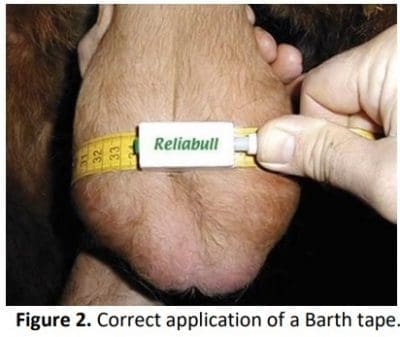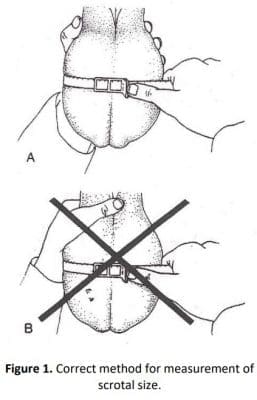THE most important factor influencing the profitability of beef operations in Australia is the number of calves weaned in comparison to the number of cows mated during the breeding season.
The bull influences the overall herd fertility more than any of the other animal. As half of the genetics of the calves come from the sires, selecting the right bulls can be the most successful way of genetically improving fertility within the whole herd.
Conversely, selecting bulls with low fertility can cause substantial losses by reducing the number of calves born. One easy measure that can help identify bulls with better fertility is to measure and record scrotal size (circumference) with BREEDPLAN.
Why Measure Scrotal Circumference?
Measuring scrotal circumference can indicate the likelihood that a bull has reached puberty, and whether testicular development is within the normal range. Scrotal circumference assessment is an important part of a Veterinary Bull Breeding Soundness Evaluation (VBBSE), which is used to assess whether bulls have normal reproductive function prior to making selection and management decisions.
Scrotal circumference is:
- A good indicator of daily sperm production especially in young bulls, which is fairly constant per gram of testis.
- A highly repeatable measure (with appropriate technique) and highly heritable (30-45%).
- Correlated with sperm motility and morphology. However, these are independently assessed as part of a routine VBBSE.
- Genetically correlated with earlier age at puberty in female relatives.
- Genetically correlated with earlier return to cyclicity after calving in female relatives within tropically adapted cattle, and especially Bos indicus cattle.
The following standards are recommended by the Australian Cattle Veterinarians when measuring scrotal size. These standards were published in 2013 as part of the VBBSE documentation. A logical sequence of events in scrotal size (circumference) measurement is to:
- Ensure the bull is safely restrained for assessment.
- Observe.
- Systematically palpate the scrotum and scrotal contents.
- Measure scrotal size.
Measurement of scrotal size first requires that the bull is restrained such that he is unable to harm either himself or the operator, and that the scrotum is readily accessible. It is advisable that:
- All materials used for bull restraint are adequate to hold the bull. All restraining facility latches are securely closed.
- Bulls are restrained with a backing bar or chain at approximately the level of the scrotal attachment.
- The bull is unable to move significantly forward from this bar, and side to side movement is significantly restricted.
- There is at least 300 mm of space behind the backing bar or chain and a further 700 mm standing room from which to safely approach the animal. A 700-800 mm high barrier in front of the standing area to work over increases safety.
Systematic visual inspection before palpation may reveal abnormalities that can be further investigated by direct palpation. If the scrotum, testes, epididymides and blood supply are considered normal, then scrotal size should be measured.
In place of a measurement, a comment outlining the reason why scrotal size was not recorded should be made; examples include left testicular hypoplasia, scrotal lesions, bilateral cryptorchid, right testicular degeneration, swollen testes, castrated, hernia.
Key elements of measurement of scrotal size to ensure high repeatability within and between operators are illustrated in Figures 1 and 2. If all of these cannot be met, a valid measurement cannot be taken or reported. The technique is:
- Both testicles are manipulated by downward massage so that they are completely within and against the lowest point in the scrotum, lying side by side, and with no evidence of wrinkling of the scrotum.
- The testes are then held firmly in the scrotum with one hand (usually the right had if the person taking the measurement is right handed). The other (usually left) hand is moved from the side and above to encircle the scrotal neck gathering up any loose scrotum and finally holding both testes firmly into the lower scrotum (Figure 1). The thumb of the hand holding the neck of the scrotum should NOT cause any pressure on the middle of the scrotum.
- The scrotal tape is then looped around the testes and placed at the level judged to have the largest circumference. The tape is then drawn firmly in contact with the entire circumference to cause moderate indentation of the scrotum.
A Barth tape (Figure 2) is the preferred instrument for measuring scrotal size.
The correct tension is achieved by placing the thumb against the piston and then firmly drawing the tape in contact with the entire circumference.
The reading is taken at the edge of the measurement block when about 2mm of green piston is showing; appearance of red indicates excessive tension.
Repeat the measurement at least once to ensure accuracy to the nearest 0.5 cm.
Other measurement devices, especially one composed of material prone to stretching should not be used, as these can lead to inaccurate measurements of scrotal size.
The Relationship Between Weight and Scrotal Size
The Bull Power Project, which ran from 1992 through to 2003, allowed the relationship between live weight and scrotal size to be examined. This project involved 1000 bulls, comprised of 2- to 4-year-old Santa Gertrudis, 5/8 Brahman, Brahman and Belmont Red bulls.
 The bulls were subjected to physical and reproductive examinations prior to mating. Many of these bulls were followed through multiple sire joining’s and mating outcomes established. Some of the finding included:
The bulls were subjected to physical and reproductive examinations prior to mating. Many of these bulls were followed through multiple sire joining’s and mating outcomes established. Some of the finding included:
Live weight appears to be a superior reference point in comparison to age as a measure for assessing acceptable scrotal circumference in young bulls. Age can also be used, but the variation at any age is higher because of nutrition effects on weight per day of age.
Across the 13 breeds included in the study, scrotal circumference x weight relationships have the same pattern in most breeds. The range across breeds of average scrotal circumference at any weight between 250-750kg is 5-7 cm as shown in Figure 3. Temperate breeds tend to have larger scrotal circumference at the same weight than tropically adapted breeds; some of this is related to the lower width to length ration of Bos indicus testes.
 There is no clear point at which a scrotal circumference indicates an increased risk to fertility. Thus, scrotal circumference needs to be interpreted along with other elements of the physical examination, and with crush side semen and morphology results if available. Bulls with a scrotal circumference that is not within “normal limits” should be viewed with suspicion unless it can be shown by other means that this does not pose a risk.
There is no clear point at which a scrotal circumference indicates an increased risk to fertility. Thus, scrotal circumference needs to be interpreted along with other elements of the physical examination, and with crush side semen and morphology results if available. Bulls with a scrotal circumference that is not within “normal limits” should be viewed with suspicion unless it can be shown by other means that this does not pose a risk.
Details of normal scrotal circumference in the Australian bull population are provided in Figure 4. As a general principle, it is recommended that the minimum acceptable scrotal circumference is the bottom 5pc value at any weight. It should be noted that the minimum recommended is “bare minimum”.
For example, bulls close to the minimum threshold are more likely to suffer from some of the problems associated with small scrotal circumference than bulls well above the threshold. Bull breeders may consider setting a higher scrotal circumference minimum for sale bulls than what is indicated by normal range.

What considerations should be made when recording scrotal circumference information for BREEDPLAN?
BREEDPLAN can analyse scrotal circumference information from bulls that are between 300 – 700 days of age when measured. Subsequently, it is essential that scrotal circumference information is recorded when bulls are within this age range.
It is recommended that you measure scrotal circumference when the bulls are reaching puberty, which will vary according to seasonal conditions and the maturity pattern of your cattle. In the majority of cases, scrotal circumference should be recorded when bulls are being weighed at 400 days.
While more than one scrotal circumference measurement can be recorded for an individual animal, BREEDPLAN is only analysing the first measurement for each bull at this stage. Subsequently, it is only necessary to record one scrotal circumference measurement on each bull.
- For further information on collecting scrotal circumference measurements on bulls, contact staff at Southern Beef Technology Services (SBTS) or Tropical Beef Technology Services (TBTS).

